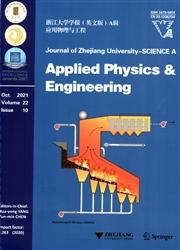等法向荷载和等法向高度边界下冻砂-混凝土界面直剪特性
IF 3.9
3区 工程技术
Q1 ENGINEERING, MULTIDISCIPLINARY
引用次数: 1
摘要
冻结土-结构界面的抗剪强度特性是评价冻结土中桩基耐久性的关键。在两种边界条件(恒定法向载荷(CNL)和恒定法向高度(CNH))下,在三种法向应力(100、200和300 kPa)和三种温度(- 2、- 5和- 8°C)下,研究了冻结砂-混凝土界面的剪切特性。通过详细的对比分析,探讨了影响剪切/法向剪切位移的主要因素。结果表明:CNL作用下冻结砂-混凝土界面的剪切特性与CNH作用下相似;剪切应力-剪切位移表现出应变软化。温度和法向应力是影响合金法向性能的主要因素。温度越低,法向应力越高,弹性剪切模量越大。峰值剪应力和临界剪应力随正应力的变化而变化。随着温度的降低,峰值剪应力呈指数增长。临界剪应力与温度有关。峰值剪应力中冰结峰值的值和百分比受温度和正应力的影响。目的 探究不同边界条件下,初始法向应力和温度对冻结砂-混凝土接触面剪切变形和强度特性、法向变形特性以及冰胶结特性的影响。 创新点 1. 在不同边界条件下对冻结砂-混凝土结构进行直剪试验,了解接触面法向和切向特性;2. 建立试验模型,成功模拟弹性剪切模量和强度随温度及初始法向应力的变化关系。 方法 1. 通过实验分析,得到冻结接触面弹性模量和强度特性随温度和初始法向应力的变化(图14∼21和表2∼5);2. 通过理论推导,构建温度、法向应力与弹性剪切模量和剪切强度之间的关系,得到相应的计算模型(公式(1)∼(6))。 结论 1. 不同边界条件下,冻结接触面均表现出应变软化特性;2. 弹性剪切模量随初始法向应力的增加和温度的降低呈线性增长趋势;3. 冻结接触面剪切强度随初始法向应力的增加线性增长,而随温度的降低呈指数增长。本文章由计算机程序翻译,如有差异,请以英文原文为准。
Frozen sand—concrete interface direct shear behavior under constant normal load and constant normal height boundary
The shear strength properties of the frozen sand—structure interface are critical for evaluating the serviceability of pile foundations in frozen ground. The shear characteristics of the frozen sand—concrete interface were studied with two boundary conditions (constant normal load (CNL) and constant normal height (CNH)), at three normal stresses (100, 200, and 300 kPa), and at three temperatures (−2,−5, and −8 °C). A detailed comparative analysis was performed to explore the principal factors affecting the shear/normal-shear displacement. The results showed that the shear behavior of the frozen sand—concrete interface under CNL was similar to that under CNH. The shear stress—shear displacement exhibited strain softening. The temperature and normal stress were the major influences on normal properties. The lower the temperature and the higher the normal stress, the greater was the elastic shear modulus. The peak shear stress and critical shear stress exhibited a dependence on normal stress. An exponential growth in the peak shear stress was observed as the temperature decreased. Critical shear stress was dependent on temperature. The value and percentage of peak ice-cementation in peak shear stress was affected by temperature and normal stress. 目的 探究不同边界条件下,初始法向应力和温度对冻结砂-混凝土接触面剪切变形和强度特性、法向变形特性以及冰胶结特性的影响。 创新点 1. 在不同边界条件下对冻结砂-混凝土结构进行直剪试验,了解接触面法向和切向特性;2. 建立试验模型,成功模拟弹性剪切模量和强度随温度及初始法向应力的变化关系。 方法 1. 通过实验分析,得到冻结接触面弹性模量和强度特性随温度和初始法向应力的变化(图14∼21和表2∼5);2. 通过理论推导,构建温度、法向应力与弹性剪切模量和剪切强度之间的关系,得到相应的计算模型(公式(1)∼(6))。 结论 1. 不同边界条件下,冻结接触面均表现出应变软化特性;2. 弹性剪切模量随初始法向应力的增加和温度的降低呈线性增长趋势;3. 冻结接触面剪切强度随初始法向应力的增加线性增长,而随温度的降低呈指数增长。
求助全文
通过发布文献求助,成功后即可免费获取论文全文。
去求助
来源期刊

Journal of Zhejiang University-SCIENCE A
工程技术-工程:综合
CiteScore
5.60
自引率
12.50%
发文量
2964
审稿时长
2.9 months
期刊介绍:
Journal of Zhejiang University SCIENCE A covers research in Applied Physics, Mechanical and Civil Engineering, Environmental Science and Energy, Materials Science and Chemical Engineering, etc.
 求助内容:
求助内容: 应助结果提醒方式:
应助结果提醒方式:


